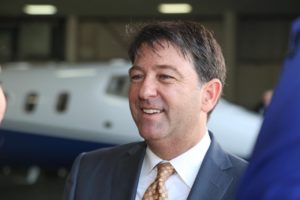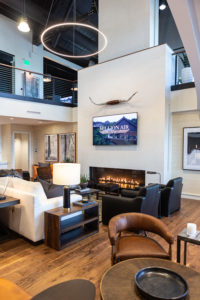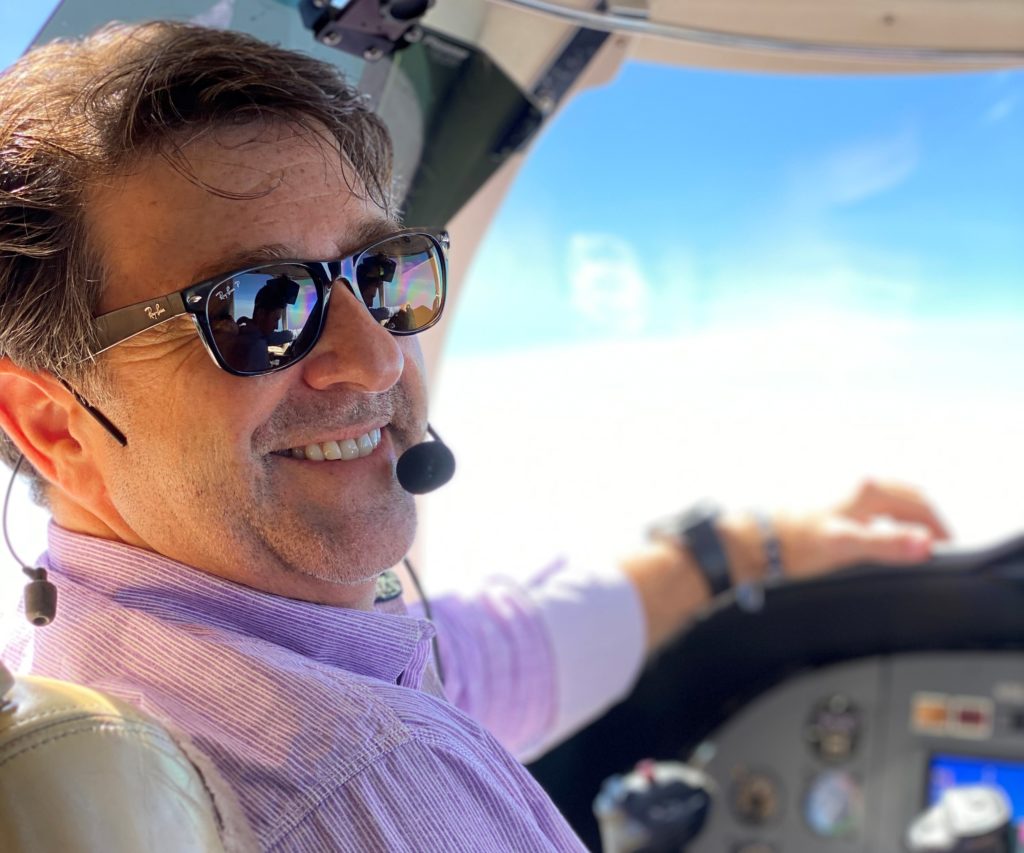Walking around the Million Air Austin FBO you get to fully appreciate the phrase southern hospitality. As soon as you enter the facility you are met with a warm welcome from each member of the team you meet. The stunning facility has a complimentary Starbucks and a fully equipped bar. There are two pilot restrooms, a chic flight planning room, a fireplace and numerous seating areas, both up and downstairs in the floor to ceiling glass building.
Throughout the FBO there are discreet décor choices that highlight aviation and Austin. Large glass tables incorporate aircraft parts while pieces of artwork dotted around depict the local region. A wraparound balcony overlooks the tarmac, giving customers the perfect place to sit and admire the many aircraft parked there.
Million Air has even expressed its artistic flair on the drive up to the FBO, with big street art style graffiti murals on the side of the hangers, a nod to Austin’s art scene.
The FBO is stylish and every detail has been carefully planned. Austin is one of Million Air’s smaller facilities, but I’m told each FBO on the company’s roster has been executed to the same high standard.
The whirring of helicopter blades indicates that Roger Woolsey, the CEO of Million Air has arrived from the company’s headquarters in Houston, ready to sit down and discuss this fascinating family business in more depth.
“Growing up I always wanted to be a pilot. I lived close to an airport, saw aeroplanes, went to air shows and fell in love with aviation,” says Woolsey, “But my career path was nothing but a lightning bolt of luck.
“Although I didn’t know it at the time, as a kid one of the yards I mowed belonged to a pilot. He was watching me working on becoming a pilot and getting my ratings.
 “By the age of 18, he had set me up to fly for Eric Clapton and all these other famous entertainers. So at 18 I was flying Stevie Nicks on a Vickers VC10, a British aeroplane, on a Fleetwood Mac world tour.
“By the age of 18, he had set me up to fly for Eric Clapton and all these other famous entertainers. So at 18 I was flying Stevie Nicks on a Vickers VC10, a British aeroplane, on a Fleetwood Mac world tour.
“I flew for some of the greats, Billy Joel, Sting, Elton John, it was nuts. I was very lucky to be so young and have such an amazing opportunity to see the world and be around these artists.”
Flying different artists on their world tours planted the seed for his company. Unlike being a pilot for large corporations that leave and return to the same city every night, he was flying to somewhere different each day.
“Flying bands shaped a lot of my thinking about this business, because I was a customer at FBOs,” says Woolsey. “I got educated in what people want from an FBO. I saw it done well in some areas, and poorly in others.
“I noticed that the service was always what made the difference though, because the infrastructure in the 80s and 90s was nothing like what we are sitting in today.”
Million Air therefore strives to achieve impeccable customer service.
“I think Million Air truly puts the class into first class in this type of business. In the old days these were gas stations at the airport. Now there’s an elegance and a sophistication to what we do,”
says Woolsey.
He also believes that customers still want to have a little bit of fun when traveling with the company and he tries to encourage that culture in the business: “We take our jobs very seriously, but we never take ourselves seriously and a lot of that comes from the rock’n’roll days.”
Expansion strategy
Woolsey notes that many businesspeople ask him how big he is intending to grow the company and what his exit strategy will be. He insists that he hates both those questions.
“I don’t know how big we are going to get. We are going to grow to what feels right. But I don’t want to grow for growth’s sake.”

Million Air is the third largest FBO operator in the USA with 36 locations. “We’re not the largest, but I don’t mind being smaller and more exclusive. We are careful to grow where the customers want us and where we feel that we can really make a difference.”
This strategy seems to be working well. The company has recently proposed a new project at Pease International Airport in Portsmouth, New Hampshire which includes a two-story FBO with an attached hangar and a fuel farm. But Woolsey explains there has been some push back from the local community: “We see such great opportunity at Pease International Airport, but there’s been a very long process with the community.
We are having lots of public meetings and listening very intently. We have made some adjustments to our plans, because there are some good ideas that bubble up through that process.
Woolsey says that it is unusual for a community to be as involved as Pease International’s is, but it isn’t a deterrent to expanding there. “You are always going to have some people raise concerns but we love our local communities.
“We really believe that our real product is to present the first impression of a community. That’s really what we do,” Woolsey says. “We happen to fund our payroll and these buildings through the sales of Jet A. But we are really all about communities.

“First impressions are created in the first six seconds of meeting somebody, and we think that if somebody lands at one of our locations, it’s our job to represent that city.
“It’s a small and tight knit community around Pease, that has a strong environmental conscience, and
we are a very environmentally conscious company.”
Sustainability initiatives
Million Air recently opened a facility at Bozeman Yellowstone International Airport, Montana. The FBO has a 300,000 gallon fuel farm and new fuel trucks. The company plans to renovate the facility. The plans include several sustainable elements.
Woolsey says, “Sustainability is something that is close to my heart. I don’t know if we have all the answers yet – I’d say we are still in learning mode. But every building we touch now has to have a solar aspect to it.
“For example, at Bozeman we’re doing a remodel and the hangars will have solar panelling. We are using reclaimed woods and other reclaimed materials in the buildings. Everything here in the Austin FBO came from sustainable sources. We are trying to grow up and get smart about it.”
The company is also installing EV charging stations at its facilities, in the Million Air corporate green colors, naturally.
The decision to install solar panels is not a new one for the company and their installation has not always gone to plan at previous facilities.
“We decided to install solar panels at White Plains, but the roofing package which we had already paid
US$6 million for couldn’t hold the weight. We are never going to design a building again which can’t handle the stress and the weight of solar paneling.
“We are changing our bulbs, using electric ground power units at some of our locations, and biodiesel for some of our field trucks.
“We are making changes where it makes sense to and where financially we can do it, while still giving back to our customers. It may be a slow process, but we will get there.”
Woolsey has worked in business aviation for a long time and believes in the resilience of the sector.
“We came through the financial crunch of the late 1980s, there was the Gulf War and 9/11 and the pandemic. We’ve had video conferencing now for a long time, but people still value face-to-face meetings, so there will be a need for aviation in the future. I don’t see then industry declining.”
He believes one of the most important things people in the industry can do is to promote awareness of what the sector does.

“A private jet is not just a rich person’s toy to go to the beach – they create jobs, they create industries, they save lives. We happen to be one of the largest organ procurement organizations in the world. We are flying heart, lung, liver transplants every single day. We have a couple of charter elements specifically for that.”
The upcoming year is looking promising for Million Air. The company plans to start operations next month in Birmingham, Alabama by working out of an existing property that is already there. Though Woolsey assures that it won’t be long before he sprinkles some Million Air magic on the site.
“The Alabama property is an aged lease. So, we will come in and make her look a little better for a little while. But we are designing a new facility. We are doing master planning of the hangars and we’re going to put in all new infrastructure, but it is going to take us a couple of years to get to where we want it to be.
“But give me the tent and my people and I will compete against any competitor and their castle.”





